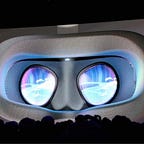3 New Medical Imagining Technologies that have Neuroscientists salivating like Pavlov’s dogs.
These three exciting new medical scanning technologies have neuroscientists dreaming about the prospects of next generation of medical imaging that is better, cheaper, more affordable, and more accessible to researchers worldwide than existing medical imaging technologies.
Article by Micah Blumberg, Neurohaxor, Organizer of NeurotechSF, and host of the Neural Lace Podcast http://neurotechx.com/
1. The first is Openwater by Mary Lou Jepson
Openwater may or may not involve Holography, Lightfields, some variant of Tractography (the technology umbrella that includes Diffusion Tensor Imaging), and Geometric Neural Networking Analytics. Some Neuroscientists are speculating that Openwater’s NIR Holographic technology is similar to another technology which you can read about called OpenNirs at opennirs.org
Openwater Reference: “Wearable scanners will be able to read our minds” https://www.ft.com/content/bfd733b0-e501-11e7-a685-5634466a6915
Also Read: Why Mary Lou Jepsen left Facebook: To transform Healthcare and Invent Consumer Telepathy https://spectrum.ieee.org/the-human-os/biomedical/imaging/why-mary-lou-jepsen-left-facebook-to-transform-heath-care-and-invent-consumer-telepathy
My questions: Why is Mary Lou’s tech holographic? Is it like Tractography?
How similar is it to OpenNIRS and is OpenNirs also holographic or is that the big difference between OpenNirs and OpenWater? Opennirs.org
2. The second is Furaxa microwave imaging Joel Libove.
Furaxa
http://www.furaxa.com/
Read Furaxa Paper:
http://ewh.ieee.org/r5/denver/apmtt/files/talk/34522.pdf
3. The third is Open Electrical Impedance Tomography
“Low Cost Non-Invasive Biomedical Imaging
An Open Electrical Impedance Tomography Project”
https://media.ccc.de/v/34c3-8948-low_cost_non-invasive_biomedical_imaging
OpenEIT
Can we apply the principle of Holography or Tractography to OpenEIT?
Read Electrical impedance tomography
https://en.m.wikipedia.org/wiki/Electrical_impedance_tomography
Pavlov Dog Reference in the title:
https://www.simplypsychology.org/pavlov.html
Opinion: AR VR Headsets can also be considered a new form of Brain Computer Interface, lets get these new Medical Sensing Technologies embedded in future AR VR headset designs.
End of story.
Previous story: This is my opinion on how Qualcomm could improve their XR Headset Reference Design. What’s your opinion? If you could design the ultimate mobile all in one AR/VR headset what would that look like, what features would it have?
